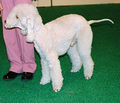| This article has been peer reviewed but is awaiting expert review. If you would like to help with this, please see more information about expert reviewing. |
Signalment
- Common in dogs, especially young to middle-aged dogs.
- Mixed and purebred dogs are affected but there is a familial predisposition in:
Description
Chronic hepatitis is an inflammatory-necrotising disease of at least 6 months duration. It is characterised by hepatocellular apoptosis or necrosis, a variable mononuclear or mixed inflammatory cell infiltrate, regeneration and fibrosis (1). It predominantly consists of lymphocytic-plasmacytic inflammatory infiltration.
A number of aetiologies include:
- Familial predisposition
- Copper accumulation (copper storage disease)
- This may be a cause or consequence of chronic hepatitis. Copper is normally excreted in bile, therefore it can occur with any cholestatic hepatobiliary disorder.
- Chronic drug therapy
- Infectious, for example infectious canine hepatitis
- Autoimmune or steroid responsive disorder
Diagnosis
Clinical Signs
These include:
- anorexia, lethargy and depression
- weight loss
- vomiting and diarrhoea
- polyuria and polydipsia
- ascites - most consistent in dogs with cirrhosis
- and rarely icterus, seizures, fever and bleeding diathesis
Laboratory tests
Haematology
- Mild non-regenerative anaemia and microcytosis
Biochemistry
- Increased alanine aminotransferase (ALT) and alkaline phosphatase (ALP). However these may not be increased if end-stage cirrhosis is reached.
- Hyperbilirubinaemia
- Hypoalbuminaemia
- Hyperglobulinaemia
- Decreased blood urea nitrogen (BUN)
- Hypoglycaemia
Further tests
- Increased bile acids
- Abnormal ammonia tolerance test
- Increased prolonged activated partial thromboplastin time (APTT) and prothrombin time (PT) indicates severe liver dysfunction or disseminated intravascular coagulation (DIC)
Imaging
Radiography
Abdominal radiographs will only reveal microhepatica or ascites when advanced stages of disease are reached.
Ultrasonography
Ultrasonographically, liver may be normal or non specific changes in echogenecity may be seen in early stages of the disease. In cases of cirrhosis, microhepatica, irregularity in hepatic margin, focal lesions corresponding to regenerative nodules, hyperechogenicity of liver parenchyma associated with increased fibrous tissue and ascites may be seen.
Histopathology
This is required for definitive diagnosis and to differentiate chronic hepatitis from other hepatopathies. Chronic hepatitis is characterised by moderate to severe lymphoplasmacellular inflammation and necrosis of the hepatocytes adjacent to the portal tracts.
Treatment
- Glucocorticoids
- Taper down with improved clinical signs and normal liver enzymes values.
- This is not indicated for chronic hepatitis caused by drug therapy, primary copper accumulation or infectious agents.
- Response to treatment should be followed up by liver biopsy 3-6 months later as glucocorticoid causes steroid induced ALP
- Ursodeoxycholic acid at 15mg/kg PO SID
- It is a synthetic hydrophilic bile acid that has hepatoprotective (anti-inflammatory, immunomodulatory and antifibrotic effects) properties and choleretic effect. It expands the bile acid pool and displaces potentially hepatotoxic hydrophobic bile acids that accumulate in cholestasis.
- Vitamin E
- An antioxidant to scavenge free radicals which may contribute to oxidative hepatocellular injury.
- Copper chelation if copper exceeds 2000ppm
- Penicillamine
- Zinc
Prognosis
Response to treatment is variable. Poor prognosis for dogs with fibrosis and cirrhosis.
References
- (1) Van den Ingh, TSGAM et. al. (2006). Morphological classification of parenchymal disorders of the canine and feline liver. In Rothuizen J et. al., editors: WSAVA standards for clinical and histological diagnosis of canine and feline liver disease, Oxford, England, Saunders.
- Ettinger, S.J. and Feldman, E. C. (2000) Textbook of Veterinary Internal Medicine Diseases of the Dog and Cat Volume 2 (Fifth Edition) W.B. Saunders Company.
- Nelson, R.W. and Couto, C.G. (2009) Small Animal Internal Medicine (Fourth Edition) Mosby Elsevier.







